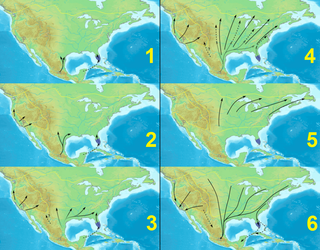Related Research Articles

The monarch butterfly or simply monarch is a milkweed butterfly in the family Nymphalidae. Other common names, depending on region, include milkweed, common tiger, wanderer, and black veined brown. It may be the most familiar North American butterfly, and is considered an iconic pollinator species. Its wings feature an easily recognizable black, orange, and white pattern, with a wingspan of 8.9–10.2 cm(3+1⁄2–4 in) A Müllerian mimic, the viceroy butterfly, is similar in color and pattern, but is markedly smaller and has an extra black stripe across each hindwing.

The Connecticut warbler is a small songbird of the New World warbler family.
Phenology is the study of periodic events in biological life cycles and how these are influenced by seasonal and interannual variations in climate, as well as habitat factors.

Lotus corniculatus is a flowering plant in the pea family Fabaceae, native to grasslands in temperate Eurasia and North Africa. Common names include common bird's-foot trefoil, eggs and bacon, birdsfoot deervetch, and just bird's-foot trefoil, though the latter name is often also applied to other members of the genus.

Vanessa cardui is the most widespread of all butterfly species. It is commonly called the painted lady, or formerly in North America the cosmopolitan.

Citizen science is scientific research conducted, in whole or in part, by amateur scientists. Citizen science is sometimes described as "public participation in scientific research", participatory monitoring, and participatory action research whose outcomes are often advancements in scientific research by improving the scientific community's capacity, as well as increasing the public's understanding of science.
The Cornell Lab of Ornithology is a member-supported unit of Cornell University in Ithaca, New York, which studies birds and other wildlife. It is housed in the Imogene Powers Johnson Center for Birds and Biodiversity in Sapsucker Woods Sanctuary. Approximately 250 scientists, professors, staff, and students work in a variety of programs devoted to the Lab's mission: interpreting and conserving the Earth's biological diversity through research, education, and citizen science focused on birds. Work at the Lab is supported primarily by its 75,000 members. The Cornell Lab publishes books under the Cornell Lab Publishing Group, a quarterly publication, Living Bird magazine, and a monthly electronic newsletter. It manages numerous citizen science projects and websites, including the Webby Award-winning All About Birds.

The blue dasher is a dragonfly of the skimmer family. It is the only species in the genus Pachydiplax. It is very common and widely distributed through North America and into the Bahamas.

eBird is an online database of bird observations providing scientists, researchers and amateur naturalists with real-time data about bird distribution and abundance. Originally restricted to sightings from the Western Hemisphere, the project expanded to include New Zealand in 2008, and again expanded to cover the whole world in June 2010. eBird has been described as an ambitious example of enlisting amateurs to gather data on biodiversity for use in science.
SABAP2 is the acronym for the Southern African Bird Atlas Project 2, which is the follow-up to the Southern African Bird Atlas Project. The first atlas project took place from 1987 to 1991. The current project was a joint venture between the Animal Demography Unit at the University of Cape Town, BirdLife South Africa, and the South African National Biodiversity Institute (SANBI). Following the closure of the Animal Demography Unit, the project is now managed by the FitzPatrick Institute of African Ornithology, University of Cape Town. The project aims to map the distribution and relative abundance of birds in southern Africa, and the original atlas area included South Africa, Lesotho, and Eswatini, although since 2012 the project has expanded to include Namibia, Botswana, Zimbabwe and Mozambique. SABAP2 was launched on 1 July 2007. The field work for this project is conducted by more than 1700 volunteers, known as citizen scientists – they collect the data in the field at their own cost and in their own time. As such they make a huge contribution to the conservation of birds and their habitat.

Chandler Seymour Robbins was an American ornithologist. His contributions to the field include co-authorship of an influential field guide to birds, as well as organizing the North American Breeding Bird Survey.

A butterfly count is an event that is organized for the purpose of identifying and counting butterflies in a specific geographical area. Butterfly counts occur regularly in North America and Europe.

Monarch butterfly migration is the phenomenon, mainly across North America, where the subspecies Danaus plexippus plexippus migrates each summer and autumn to and from overwintering sites on the West Coast of California or mountainous sites in Central Mexico. Other subspecies perform minor migrations or none at all. This massive movement of butterflies has been called "one of the most spectacular natural phenomena in the world".

Participatory monitoring is the regular collection of measurements or other kinds of data (monitoring), usually of natural resources and biodiversity, undertaken by local residents of the monitored area, who rely on local natural resources and thus have more local knowledge of those resources. Those involved usually live in communities with considerable social cohesion, where they regularly cooperate on shared projects.

Karen Suzanne Oberhauser is an American conservation biologist with a specific interest in monarch butterflies.

Kathy Martin is a global authority on arctic and alpine grouse and ptarmigan, and on tree cavity-nesting vertebrates. She is a professor in the Faculty of Forestry at the University of British Columbia and a senior research scientist with Environment and Climate Change Canada.

Several studies report a substantial decline in insect populations. Most commonly, the declines involve reductions in abundance, though in some cases entire species are going extinct. The declines are far from uniform. In some localities, there have been reports of increases in overall insect population, and some types of insects appear to be increasing in abundance across the world.
The Plant Phenology Ontology (PPO) is a collection of OBO Foundry ontologies that facilitate integration of heterogeneous data about seed plant phenology from various sources. These data sources include observations networks, such as the National Ecological Observatory Network (NEON), the National Phenology Network (NPN), and the Pan-European Phenology Database (PEP725), remote sensing, herbarium specimens, and citizen science observations. The initial focus during ontology development was to capture phenological data about one plant or a population of plants as observed by a person, and this enabled integration of data across disparate observation network sources. Because phenological scorings vary in their methods and reporting, this allows these data to be aggregated and compared. Changes in plant phenology can be linked to different climate factors depending on the species, such precipitation or growing degree days. Aggregated data about the timing of plant life cycle stages at different places and times can provide information about spatiotemporal patterns within and among species, and potentially offer insight into how plants may change or shift their life cycles in response to climate change. These shifts can have implications for agriculture and various biodiversity research avenues, such as shifts in pollinator and host life cycles.
Avibase is an online taxonomic database that organizes bird taxonomic and distribution data globally. At its core, the database relies on the notion of taxonomic concepts. rather than taxonomic names. Avibase incorporates and organizes taxonomic data from the main avian taxonomic publishers and other regional sources. Taxonomic concepts in over 230 different taxonomic sources have been mapped and cross-referenced to Avibase concepts.

Jeremy Kerr is a Biology professor at the University of Ottawa where he holds the University Research Chair in Macroecology and Conservation. Kerr is a member of the NSERC Council, including its Executive Committee, and the past president of the Canadian Society for Ecology and Evolution (CSEE). He is the Chair of NSERC's Committee on Discovery Research.
References
- ↑ Beal, Tom (25 September 2015). "UA butterfly researcher gets White House invitation". tucson.com. Retrieved 31 October 2015.
- ↑ Semeniuk, Ivan (7 October 2018). "The butterfly effect: How Canadians and their smartphones are helping scientists map species diversity". The Globe and Mail. Archived from the original on 8 October 2018. Retrieved 12 October 2018.